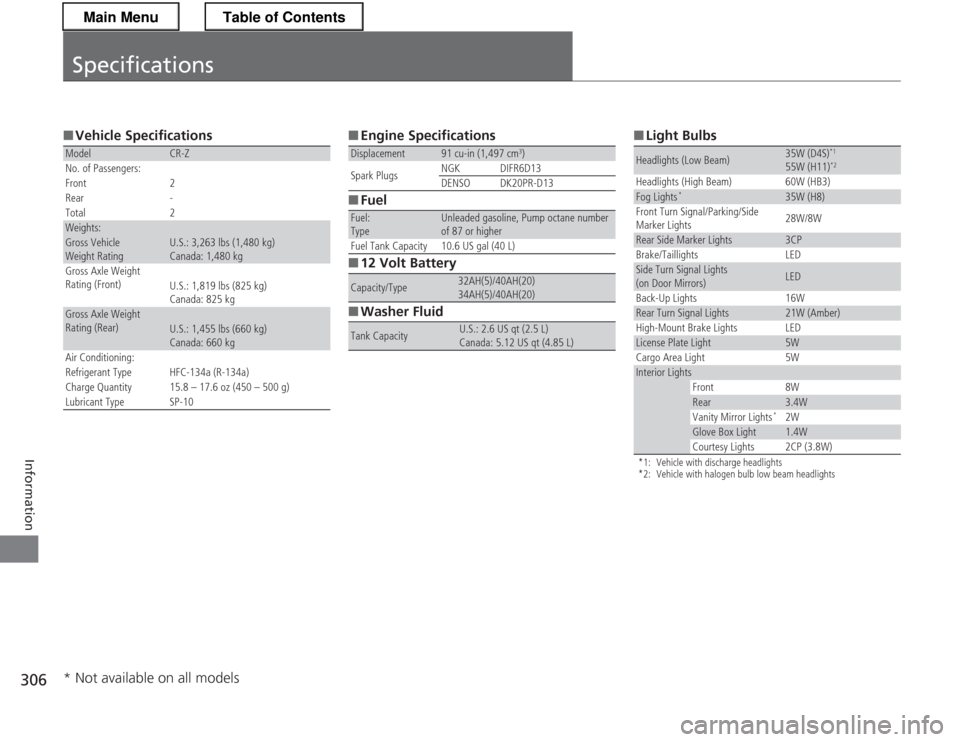Page 275 of 325

uuIf a Tire Goes FlatuChanging a Flat Tire*
274
Handling the Unexpected
1. Place the jack under the jacking point
closest to the tire to be changed.
2. Turn the end bracket (as shown in the
image) clockwise until the top of the jack
contacts the jacking point.
uMake sure that the jacking point tab is
resting in the jack notch.
3. Raise the vehicle, using the jack handle bar
and the jack handle, until the tire is off the
ground.
■How to Set Up the Jack1How to Set Up the Jack
Do not use the jack with people or luggage in the
vehicle.
Use the jack provided in your vehicle.
Other jacks may not support the weight (“load”) or their shape may not match.
The following instructions must be followed to use the jack safely.
• Do not use while the engine is running.
• Use only where the ground is firm and level.
• Use only at the jacking points.
• Do not get in the vehicle while using the jack.
• Do not put anything on top of or underneath the
jack.
3WARNING
The vehicle can easily roll off the jack,
seriously injuring anyone underneath.
Follow the directions for changing a tire
exactly, and never get under the vehicle
when it is supported only by the jack.
Jack Handle BarWheel Nut
Wrench as Jack Handle
Main MenuTable of Contents
Page 302 of 325
301
Continued
Handling the Unexpected
Emergency Towing
Call a professional towing service if you need to tow your vehicle. ■
Flat bed equipment
The operator loads your vehicle on the back of a truck.
This is the best way to transport your vehicle. ■ Wheel lift equipment
The tow truck uses two pivoting arms that go under the front tires and lift them off
the ground. The rear tires remain on the ground. This is an acceptable way to
tow your vehicle.1Emergency Towing
NOTICE
Trying to lift or tow your vehicle by the bumpers will
cause serious damage. The bumpers are not designed
to support the vehicle's weight.
NOTICE
Improper towing such as towing behind a
motorhome or other motor vehicle can damage the
transmission.
Never tow your vehicle with just a rope or chain.
It is very dangerous, since ropes or chains may shift from side to side or break.
Main MenuTable of Contents
Page 307 of 325

306
Information
Specifications
■Vehicle Specifications
ModelCR-Z
No. of Passengers:
Front 2
Rear -
Total 2
Weights:
Gross Vehicle
Weight Rating U.S.: 3,263 lbs (1,480 kg)
Canada: 1,480 kg
Gross Axle Weight
Rating (Front)
U.S.: 1,819 lbs (825 kg)
Canada: 825 kg
Gross Axle Weight
Rating (Rear)
U.S.: 1,455 lbs (660 kg)
Canada: 660 kg
Air Conditioning:
Refrigerant Type HFC-134a (R-134a)
Charge Quantity 15.8 – 17.6 oz (450 – 500 g)
Lubricant Type SP-10
■Engine Specifications
■Fuel
■12 Volt Battery
■Washer Fluid
Displacement91 cu-in (1,497 cm 3
)
Spark Plugs NGK DIFR6D13
DENSO DK20PR-D13
Fuel: TypeUnleaded gasoline, Pump octane number
of 87 or higher
Fuel Tank Capacity 10.6 US gal (40 L)
Capacity/Type32AH(5)/40AH(20)
34AH(5)/40AH(20)
Tank CapacityU.S.: 2.6 US qt (2.5 L)
Canada: 5.12 US qt (4.85 L)
■Light Bulbs
*1: Vehicle with discharge headlights
*2: Vehicle with halogen bulb low beam headlights
Headlights (Low Beam)35W (D4S) *1
55W (H11) *2
Headlights (High Beam) 60W (HB3)
Fog Lights *35W (H8)
Front Turn Signal/Parking/Side
Marker Lights 28W/8W
Rear Side Marker Lights3CP
Brake/Taillights LED
Side Turn Signal Lights
(on Door Mirrors)LED
Back-Up Lights 16W
Rear Turn Signal Lights21W (Amber)
High-Mount Brake Lights LED
License Plate Light5W
Cargo Area Light 5W
Interior Lights
Front 8W
Rear3.4W
Vanity Mirror Lights *
2W
Glove Box Light1.4W
Courtesy Lights 2CP (3.8W)
* Not available on all models
Main MenuTable of Contents
Page:
< prev 1-8 9-16 17-24